How Does Smart (Switchable) Glass Work?
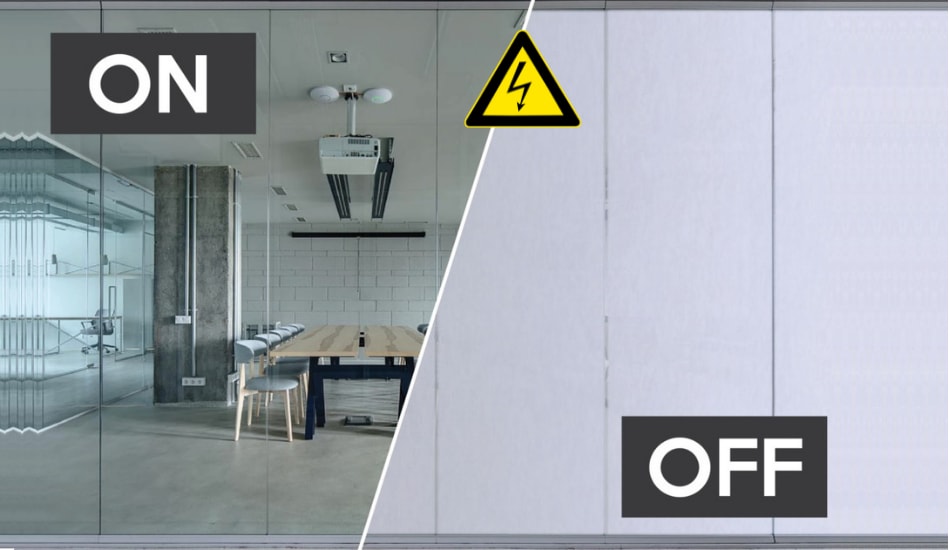
Smart glass is a great option if you want to optimize the view in your home and business environment. By using it, you can have privacy whenever you want. Another great thing about smart (switchable) glass is that it gives a minimalist look. It uses special and modern technology, which reduces the need for curtains and blinds on your windows. In a second, you can light up or darken the room by remote access. But without too much procrastination, let’s talk about how smart glass works.
So How Does Smart (Switchable) Glass Work? Active Smart Glass technology is using electricity for the control of various forms of light (visible, UV, IR). Electricity allows the glass to switch from transparent to opaque and versa, allowing dynamic light control. Smart glass operates on 110V AC power and uses 3-5 W per square meter.
Although this is just a basic principle of how smart (switchable) glass works, there is an even more detailed (chemical) explanation below, which we will touch on later. Keep in mind that there are two types of smart glass: active and passive.
This depends on whether the changeability on smart glass requires or not an electrical charge. If it requires, then it’s active, if not, then it’s passive. Usually, when we talk about smart glass, it mainly refers to active.
Active smart (switchable) glass technology usually includes the following:
- Polymer Dispersed Liquid Crystal (PDLC) glass: Typically used in various industries.
- Suspended Particle Device (SPD) glass: Most often used in automotive and building.
- Electrochromic Device (ECD) glass: Windows that are coated and that slowly tint for shading.
Advantages of Smart Glass:
- Self-tinting capabilities
- Reducing Glare
- Ability to block UV rays
- Increase energy-savings
- They are cost-efficient
Note! By using smart glass, you can eliminate the need for curtains and blinds, reducing the amount of dust in your home.
If you want to learn more, be sure to watch also this Youtube video that explains smart glass technology even more.
For those who are a little bit more curious about this technology be sure to read How Much Electricity (Power) Does Smart Glass Use?
Types of Smart Glass
Today you can find a lot of manufacturers that make smart glass, and it comes in a couple of distinct types. Some of them are electrochromic, nanocrystal, and polymer-dispersed liquid crystal (PDLC). We will explain each of them in more detail below.
1. Polymer Dispersed Liquid Crystal (PDLC) Glass
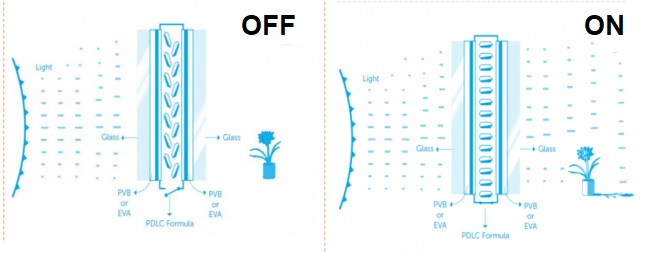
The PDLC technology integrated into the smart glass uses a special polymer instead of ions. That way, the glass can easily switch from one light mode to the next.
Once this is applied to a plastic substrate, lithium ions can be injected between glass panes. These liquid crystals are very similar to a normal LCD screen, and they can randomly block light without a voltage. When using voltage, the crystals are aligned together, blocking the passage of light.
2. Suspended Particle Device (SPD) Glass
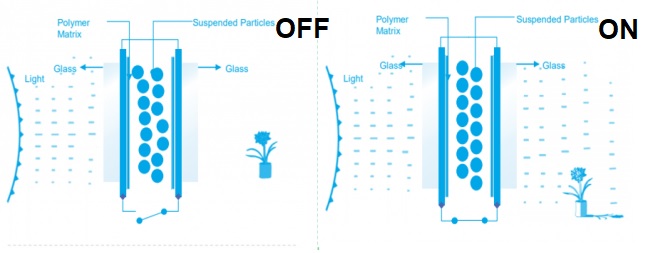
The SPD Glass uses miniscule solid particles that are coated with two thin layers of PET-ITO. A combination of that layer blocks up to 99% of natural or artificial light in a second by shifting voltage. Like PDLC, SPD technology can be easily dimmed, which allows a user a customized shading experience. It should also be noted that the SPD doesn’t completely opaque, and for that reason, it is not recommended for privacy usage, instead, it can be used for projection.
SDP glass technology is great for exterior use, but it can also be used indoors, especially in places where you need darkness. Keep in mind that only two companies in the world currently are manufacturing SPD glass.
3. Electrochromic Device (ECD) Glass
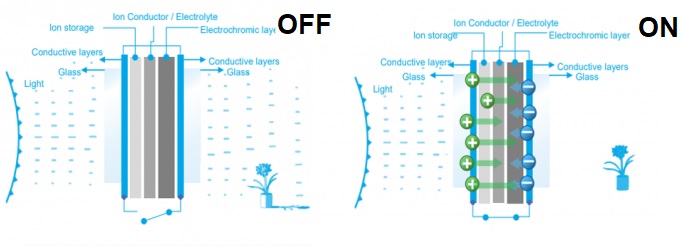
The ECD Smart Glass is in an opaque state until you send an electric charge to move it to a clear or semi-clear state. This smart glass includes polycrystalline tungsten oxide or lithium cobalt oxide layers. This usually depends on the manufacturer and glass requirements.
By aligning a special liquid crystal that is in the smart glass, you can have a transparent look. When you press the button, you activate the voltage that causes the ions to move. That way, you create a transparent light (which can be pass-through, clear) or reflective light (which can be semi-transparent, opaque).
If you want to learn more, be sure to read The Pros and Cons Of Smart Glass.
Where Is Smart (switchable) Glass Used For?
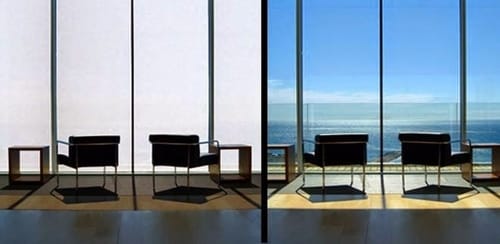
Smart or switchable glass can be used in all kinds of home or building designs, but usually, there are two main reasons why people opt for them: privacy and energy efficiency. When it comes to electrochromic and thermochromic glass, they can easily reduce the heat that enters or escapes through a glass, and that way, they can reduce energy costs when it comes to heating or air conditioning.
While saving energy is a great thing, what makes people install smart glass is its privacy in their homes and commercial properties. Today there are many situations where you can use switchable smart glass to add privacy in your daily use, such as:
Office Windows
If you have a work office with a large room that is used for meetings, you will surely find yourself in an awkward situation where someone from time to time will peek in. This can refer to private meetings, working environment, sensitive discussion, and the list goes on.
Having curtains can be a time-consuming job if you have a large office room to cover. Therefore, smart (switchable) glass is what you need in situations like this. They are fast, modern, and aesthetically pleasing in situations like this.
Hospitals
Having blinds and curtains in hospitals is not the best option to have. They accumulate dust, and they are not hygienic. That’s because they can also be the ground area for bacteria. When it comes to home or office, this doesn’t matter too much, but this can create a problem in hospitals and surgery rooms.
If you have smart or switchable glass installed, this will eliminate the need for blinds and curtains in the room. Smart glass can easily be integrated into timers, light sensors, and any other equipment.
Bathrooms
When it comes to hotels and modern homes, it is very convenient to have smart glass in the bathroom that can give you privacy. The bathroom is the place where privacy is very important, and having the option to turn it on or off quickly is a huge thing. Homeowners that have smart (switchable) glass in their bathrooms will be able to ensure privacy and still have the additional option to enjoy a view to the outside when they want to.
Hotels
As hotels are becoming more luxurious today and they are offering a large selection of things, it is necessary to keep up with modern technology. Therefore, having a smart glass in hotel guest rooms offers a great solution to guests that want to have a cozy and relaxing space with a lot of privacy at the same time. With a simple click, you can easily transform a public guest room into a private room.
Here you can see how smart (switchable) glass works.
Should I Get Smart Glass for My Home?
If you don’t want to use blinds or curtains in your home or office and at the same time you want privacy, then smart glass is the best option for you. However, before buying smart glass, be sure to consult with some experts in this field and see how much it will cost you. The installation process also requires professional help, so keep that in mind.
Which Smart Glass Do I Need?
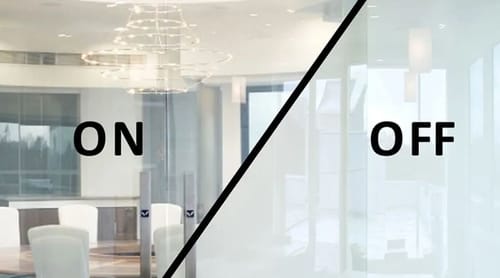
Before you opt for smart glass, know that every privacy glass technology comes with its pros over cons. When it comes to outdoor windows, they most often use PDLC, SPD, or EC technology, while for interior use, it is recommended to use PDLC that is specifically made for indoors.
The SPD for the interior is mainly used for rooms that need darkness, while the EC is a good solution for facade windows. That’s because they don’t usually require instant tinting. If you want to know which type of smart glass you need to buy for your need, we will try to help you. Below you will see the table that we have created to clarify what type of smart glass you need for which application.
| Type of Smart Glass: | Why It Is Used? | Where It Is Used? |
|---|---|---|
| PDLC (Indoor) | Instantly adds privacy without blocking light. | For Interior privacy, offices, business rooms. |
| PDLC (Outdoor) | Solar variations can control IR (heat) that comes from sunlight. | On exterior windows, privacy partitions. |
| SPD | Create a shaded space by blocking up to 99% light. Quick transition. | On car windows, Skylight Façade, trains, Galleries, etc. |
| EC | Slowly blocks light Transitions. | On small or large windows where it is not required instant shade. |
FAQ: People Also Ask
How Long Does Smart Glass Last?
Usually, Smart Glass can last 20 to 30 years, depending on its quality and manufacturer. Smart glasses that are laminated and tempered are made of much higher quality and durable material and can last even longer.
Does Smart Glass Require Electricity?
Smart Glass uses 110 V AC power to operate. It has five layers and it needs an electrical charge of around 3 to 5 watts per square foot to work. The electrochromic smart glass needs voltage (12 to 36V) to trigger lithium-ions to transfer layers of glass which makes the glass tint.
Final Thoughts
Smart glass is a technology that has been present for some time, and it is quite certain that it will stay with us for a long time. In the near future, we will see how this technology easily replaces blinds and curtains and how more and more homes will have smart glasses installed on their windows. The advantages are that it gives a minimalist design and requires almost no maintenance. I hope you learned something by reading this article and if you have any questions, leave a comment.
